With commuter ridership playing a smaller role in transit operations, agencies must reorganize their services around different travel schedules and patterns.

Writing in Governing, Skip Descant assesses how U.S. mass transit systems, which historically relied largely on commuter travel for the bulk of their ridership revenue, can adapt to new ridership patterns and adjust their services to serve new needs.
For transit agencies in Washington, D.C., where 66 percent of commuters now work from home at least part time, this is now an existential question. “Ridership on Metro, the network of trains and buses serving the nation’s capital, during the first six months of this year was down 64 percent compared to the same six-month period in 2019, according to the American Public Transportation Association (APTA).”
Some of the ways agencies are addressing these challenges: focusing on system reliability; removing friction points for users; launching more mobility options, like small shuttles linking restaurants and attractions; providing on-demand microtransit; and more focus on the first-mile/last-mile obstacles.
Transportation experts say agencies must rethink their service schedules, make it easier to access transit and make connections between systems, and focus on “transit planning that accommodates all of the other non-work trips we take — errand running, trips to schools and doctor’s appointments.”
FULL STORY: Commuter Ridership Is Disappearing. Can Mass Transit Adapt?

Planetizen Federal Action Tracker
A weekly monitor of how Trump’s orders and actions are impacting planners and planning in America.

Congressman Proposes Bill to Rename DC Metro “Trump Train”
The Make Autorail Great Again Act would withhold federal funding to the system until the Washington Metropolitan Area Transit Authority (WMATA), rebrands as the Washington Metropolitan Authority for Greater Access (WMAGA).

DARTSpace Platform Streamlines Dallas TOD Application Process
The Dallas transit agency hopes a shorter permitting timeline will boost transit-oriented development around rail stations.

LA County Creating Action Plan to Tackle Extreme Heat
Los Angeles County is creating a Heat Action Plan to help communities stay safe during extreme heat, with steps like adding more shade, improving buildings, and supporting the neighborhoods most at risk.

Maryland Plans Quick-Build Complete Streets Projects
The state will use low-cost interventions to improve road safety in five Maryland counties.

Downtown Los Angeles Gears Up for Growth
A new report highlights Downtown L.A.’s ongoing revival through major housing projects, adaptive reuse, hospitality growth, and preparations for global events in the years ahead.
Urban Design for Planners 1: Software Tools
This six-course series explores essential urban design concepts using open source software and equips planners with the tools they need to participate fully in the urban design process.
Planning for Universal Design
Learn the tools for implementing Universal Design in planning regulations.
City of Charlotte
Municipality of Princeton
Roanoke Valley-Alleghany Regional Commission
City of Camden Redevelopment Agency
City of Astoria
Transportation Research & Education Center (TREC) at Portland State University
US High Speed Rail Association
City of Camden Redevelopment Agency
Municipality of Princeton (NJ)




























